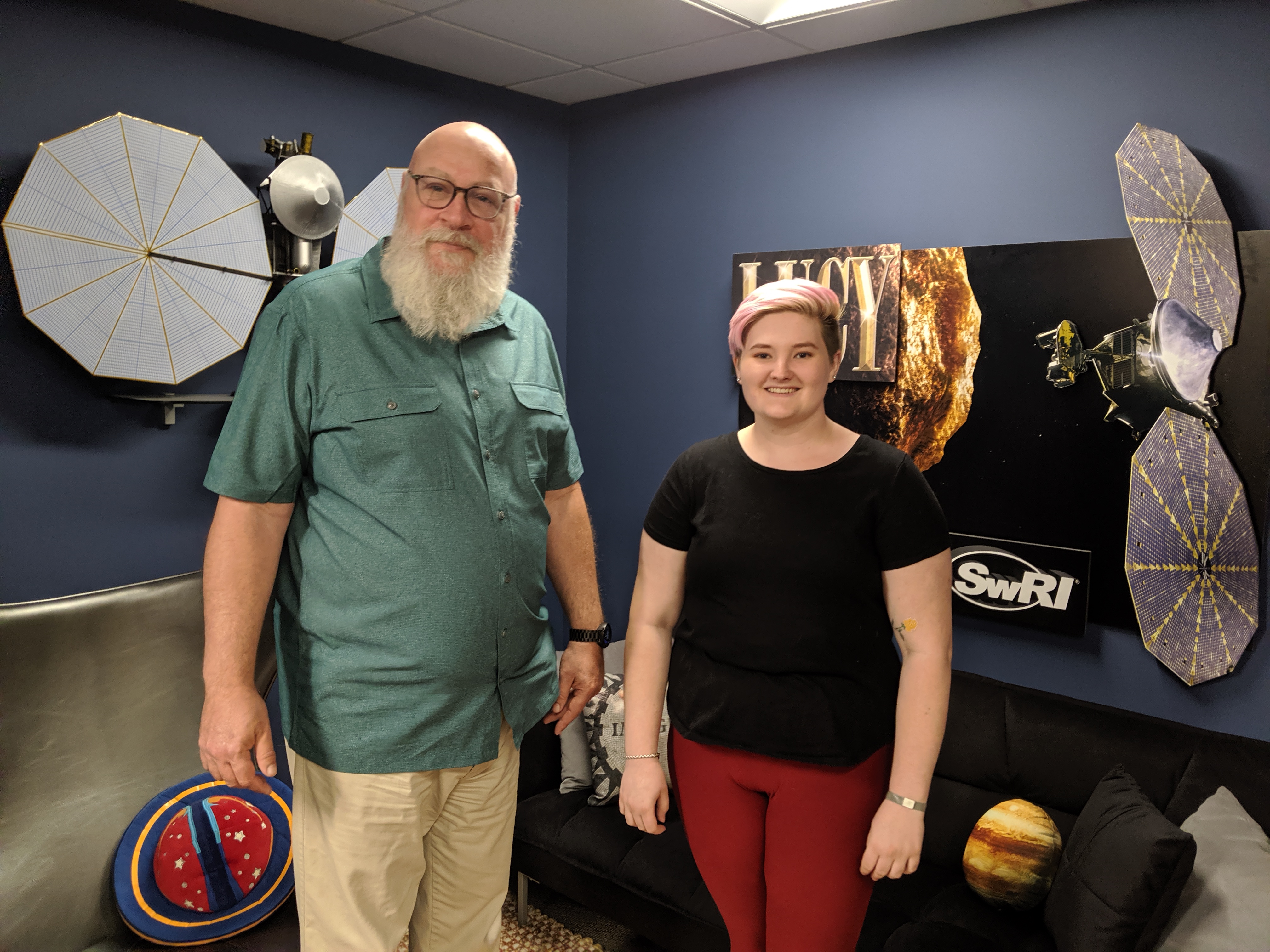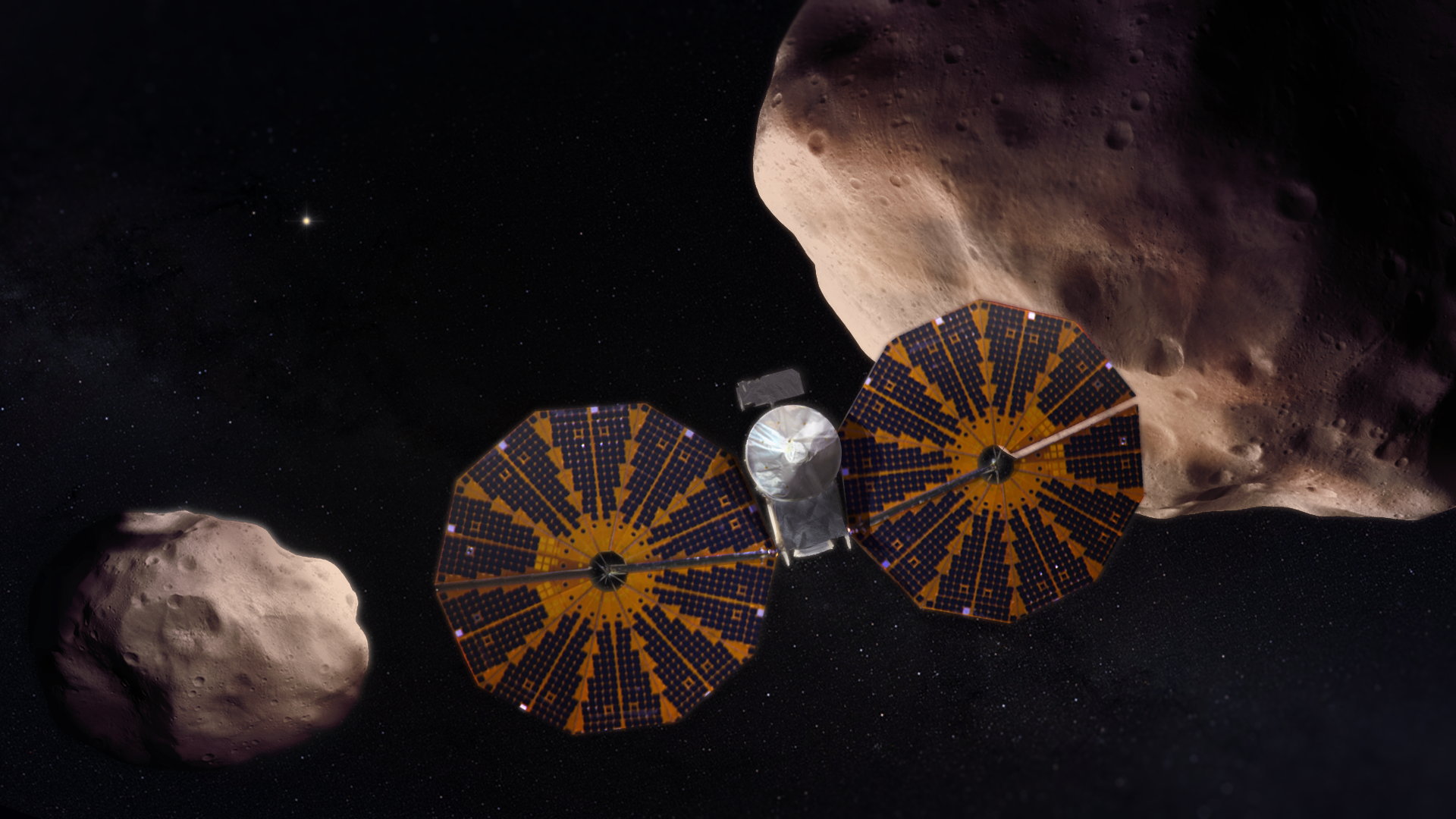An Internship with Lucy
Dec 17, 2019
By Melisa Kamrowski, Lucy Summer Intern 2019

This summer, I spent 10 weeks in Boulder, Colorado working at the Southwest Research Institute with NASA’s Lucy mission. My research was related to dynamics, which studies how and why things move the way they do. I worked with Hal Levison, the principal investigator of the mission, and three others working on Lucy or similar dynamics questions - Raphael Marschall, Katherine Kretke, and Tim Holt.
The Lucy mission consists of a probe (second picture) that is expected to launch in 2021, and will travel to Jupiter’s Trojan asteroids. The Lucy craft is going to visit 6 asteroids to take various sets of data that the Lucy team back on Earth can use to learn about things like the origin of the asteroids.

If NASA is sending a mission to these asteroids, they must be special or interesting-which they are! Trojans are asteroids that follow nearly the same orbit around the Sun as a planet - in this case Jupiter - and they exist in two regions around the planet, called the 4th and 5th Lagrange points. Trojans are thought to be ‘primordial,’ meaning they have existed since the creation of the solar system. In addition to their orbit around the Sun, Trojans follow another smaller orbit, so their actual path around the Sun ends up looking a bit like a spiral. In the first GIF shown below, you can see how this motion works. Here, the orange dot is Jupiter, the small green dots are the Trojans, and the rest of the dots are the inner planets - Mars, Earth, Venus, Mercury, and the Sun. The 4th and 5th Lagrange points is the general region that all of the green points stay inside. If you try to closely watch one of the green dots, you can see that at the same time as it orbits the sun, it moves around in smaller circles inside its Lagrange point. Even after studying things about how these asteroids move for an entire 10 weeks, I still find these asteroids and their movement in space really cool and interesting - before hearing about the Lucy mission, I had no idea this kind of path was even possible.
Now, onto what I actually did for those 10 weeks. When I first arrived, my job was to figure out if it is possible for a Trojan to hit Jupiter, meaning it would have to escape from its path around the Sun in just the right way that it would be sent on a collision course with Jupiter. We were interested in learning about this possibility because of an event that happened in 1993-1994. In 1993, three people - Carolyn Shoemaker, Eugene Shoemaker, and David Levy - discovered a comet near Jupiter, which was named comet Shoemaker-Levy 9. When the comet was discovered, it was broken up into many pieces, because at some point before it was discovered, it flew close enough past Jupiter that the planets strong gravity ripped it apart. Then in 1994, a year after it was discovered, Shoemaker-Levy 9 crashed into Jupiter. So, we wanted to try and figure out if it is possible that the comet had ever been part of the Trojan “swarms.”
To figure this out, we needed to use a software known as a numerical integrator. Essentially, this type of software uses various complex equations and physics concepts in order to calculate the theoretical path of a particle, such as an asteroid, over many millions or billions of years. We told this program to follow the path of 2,109 asteroids in and around the Trojans for 100 million years. We were hoping that the integrator results would show us a lot of particles that leave their original path and collide with Jupiter. However, the results showed us that even out of 2,109 asteroids, only three would follow the specific path we were looking for. Because this is so few - only 0.1%! - we determined that Shoemaker-Levy 9 was likely never a Trojan asteroid, and was just what is known as a Jupiter family comet - aka a comet around Jupiter.
Even though we determined that the answer to our first question was a ‘no,’ we had a lot more work we could do to learn more about how the Trojans move. The next question we decided to look into was the escape behavior of the Trojans. Starting out, we just looked at how many Trojan asteroids would leave their original location in space over 4.5 billion years, the age of the solar system. From these calculations, we found that out of the currently discovered population of 5553 Trojans, ~15.5% will escape. We compared our percentage with the data a few other people had found when they ran similar tests. Holt had run near exact tests as what we did, just using a different software for his integrator, and he found that 14.9% of Trojans would escape over 4.5 billion years. Levison, who was among the first to complete tests like these and is the co-author of a 1997 paper on the topic, wrote that 12% of Trojans escape over 4 billion years, based on calculations completed using the 178 known Trojans at that time. With these three results, there is pretty strong evidence for how many Trojans escape over time, but we did not determine a definite answer.

Finally, we looked into determining a few other things about the Trojan dynamics. Most of all, we wanted to see if we could figure out why some Trojans escape, and why some others follow unusual paths in their smaller orbit. We spent a short amount of time looking into ‘secular resonances,’ which would tell us if a Trojan moves onto a specific path because of some other body in the solar system - such as if the location of Saturn to a given Trojan caused an interesting change in how that Trojan moves around. One other really cool thing we found was that sometimes Trojans can switch Lagrange points. This means that the asteroid would start off in a stable path on one side of Jupiter, then it would somehow escape this path and move to the other side, and fall into a new stable path, but only for a short time before completely leaving the Trojan swarms. We did not get around to much more than just thinking about these questions and events, though.
In the end, I learned a lot about Trojan asteroids and the field of dynamics, but also a lot about how things work in a space science office and in NASA, and I gained a lot of skills that will help me in the future as well. I put a lot of work into learning aspects of coding in Python, which I used a lot to make graphs and look at various forms of data. I think coding experience is a very important thing for someone going into almost any science field. Aside from the science specific stuff, I did a lot of really cool things over these 10 weeks. I attended a conference full of other people who work on dynamics research, which gave me a great view into this field within space science, as well as the opportunity to talk to older people in this field and their experiences. I also got to spend some time at Lockheed Martin, the facility that is going to build Lucy in the near future, and has also built many other famous NASA missions. I am excited to move forward and apply my experience and knowledge as I finish undergrad, head into grad school, and eventually (hopefully!) return to work with NASA in the future.
Are you an undergraduate student who wants to become a Lucy Intern? Apply now for both the Spring L’SPACE Academy and the Summer Lucy Internship Program at www.lspace.asu.edu
Note: you must take the L’SPACE Academy in order to be eligible for a L’SPACE Lucy Internship